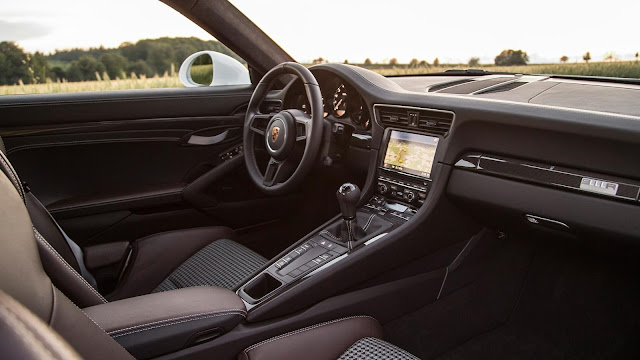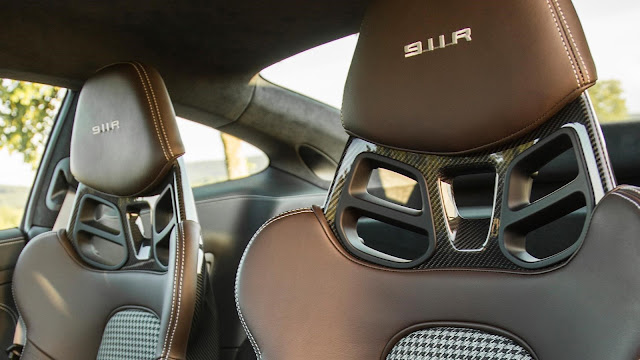Purists complained when Porsche launched the 991 GT3 and GT3 RS with only a dual-clutch automatic transmission. This car, thinks Porsche quite rightly, will shut them up. It’s the 911 R, at its simplest a GT3 shorn of aero, stuffed with more powerful GT3 RS engine, and fitted with a manual transmission.
When CAR met Mr GT3 Andreas Preuninger at the 2015 Geneva motor show, he casually referenced a car that wasn’t about lap times or aero, but was more exploitable on the road. The 911 R is that car. A total of 991 will be built, each commanding an asking price of £136,901 – £5k over an RS – and all are already sold. Yes, secondhand prices have already gone mad.
Why call it R?
Everyone remembers the 1973 RS, fewer the 1967 R, a road-going homologation car that raced in the Tour de France and Targa Florio. The original got a 2.0-litre flat-six, fibreglass hang-on panels and lightweight seats.
The R takes the GT3 bodyshell (not the GT3 RS’s XXL Turbo body) and removes the rear wing, but adds the GT3 RS double-bubble magnesium roof, carbonfibre bonnet and a pair of bespoke carbonfibre front wings – not the vented numbers that help keep the GT3 RS on the road. Polycarbonate rear and side windows further reduce weight, as they do in the RS.
Inside, there are fixed-back, carbon-shelled bucket seats, no rear seats and no half rollcage. the latter a no-cost option on the GT3. The result is the lightest 991 911, at 1370kg – that’s a claimed 50kg lighter than GT3 RS, and 60kg lighter than GT3.
What about the mechanical spec?
The R gets the GT3 RS’s 4.0-litre naturally aspirated flat six, up from the GT3’s 3.8 litres. It generates 493bhp at a sky-high 8250rpm, peak torque of 339lb ft at a lofty 6250rpm, and is 24bhp and 15lb ft clear of a GT3.
So, it wins the power-to-weight war against its siblings. The R’s 360bhp-per-tonne plays GT3’s 328bhp-per-tonne, and GT3 RS’s 347bhp-per-tonne. It’s also worth noting that Preuninger admitted Porsche was being typically conservative with power figures, and a typical 4.0 litre would produce 510-515bhp.
But on a twisty road, you may lose out to PDK-equipped GT3 and RS models – because of the R’s manual transmission. Not a seven-speeder, note, as you’ll find in the Carrera, but six.
Suspension is as per the GT3, with two-stage adjustable dampers, dynamic engine mounts (stiffening up under harder cornering and acceleration), rear-wheel steering, a locking rear diff, and carbon-ceramic brakes. You also get GT3-sized 20-inch alloys with the same 245/35 ZR20 front and 305/30 ZR20 rear Michelin Pilot Sport Cup 2 tyres as you’ll find on a GT3. The RS gets even wider, even stickier rubber, 20s up front, 325/30 ZR21 Cup 2s at the rear.
What’s it like to drive?
Sublime, if still for the committed. The fixed-back, carbon-shelled bucket seats are trimmed in leather with retro hound’s tooth fabric trim, and the steering wheel is wrapped in leather, not Alcantara. The seats are both supportive and comfortable, and no longer force my shoulders to hunch, as the old 997-generation GT3 and RS did.
If the trim suggests this car is a little more road-focussed, it is, but that’s all relative here. Road noise is so pronounced you’ll probably give up on the optional Bose stereo, and you’ll have to remember to spec air-con and sat-nav, both of which are optional. Our test car was also fitted with the optional single-mass flywheel, which helps to make the 4.0 litre’s response even more ferocious, but grumbles like a cement mixer when it’s in neutral. It gets tiresome in traffic.
Stop carping and buy a PDK convertible if the R’s too hardcore…
Exactly, Porsche has plenty of other 911s if you need something more useable. The R is all about hardcore thrills, we get that, and it’s still a very useable machine: the dampers are so supple that you can use stiffer Sport mode on the motorway without crashing about.
The reduced aero makes itself felt early on, because the R shifts around beneath you more, even at 80mph. The steering, too, seems to jiggle more: it rhythmically bobs around even if you’re pointing it dead straight, like a boat gently rocked by another’s wake.
But clearly, the big difference here is the transmission. Pressing the clutch is like doing reps in the gym, and the gear shift feels heavily spring-loaded, again adding physicality where the driver of a GT3 either taps a little paddle-shift or lets the car do it for him. The lever is stumpy, lies just a hand’s span from the wheel, and draws your eye with its carbonfibre detailing. You can take up a centimetre of slack before actually engaging the gear and then pull it hard the short distance through the gate. A Cayman’s shift is slicker, but the toil suits this car.
Press Sport and the Porsche’s ECU will blip the throttle to rev-match on downshifts (and upshifts if you’re lazy with the lever), and do it brilliantly. Perhaps ironically, de-selecting Sport and turning off that function makes for the more involving experience. At first, you won’t blip the revs enough, because there are some big gaps for those six ratios to span – around 1200rpm between third and fourth. That means you have to be really aggressive with heel-and-toe blips but understanding that, and transferring that approach to the entire way you drive the R, is key in unlocking its brilliance.
How about the engine?
Just like the manual transmission, there was some grumbling about Porsche’s dropping the Mezger flat-six from the GT3, but the latest boxer is superb – it’s one of the best production engines ever built. And, of course, it maintains natural aspiration whereas the Carreras have switched to turbocharging. That means you have to work at it – there’s that word ‘work’ again – to access all the performance, but the payoff is a throttle that zings with response, peak power at a screaming 8250rpm and a soundtrack to shame modern F1 machinery.
The R pulls with an industrial grumble from low revs before the trademark bassy howl starts to rise from around 3200rpm. Then there’s a step at around 4200rpm when things start to get really serious, and the needle spins round the central rev counter in a feral, ferocious lunge.
If you hit 7000rpm you’ll think it all incredibly intense, and when you concentrate and hit 8250rpm, it’s like you’re strapped into Apollo 13 on re-entry. Turbocharged supercars make the R feel lazy at low revs, but as Mr Preuninger observed in Geneva, ‘500bhp is enough for the road.’ It really is, and it means the R has can deploy all of its power without relying heavily on stability systems.
Reduced aero, more power… how does it handle?
Fundamentally, the R still handles like the GT3. That means well contained body roll, astonishingly pure front-end response with high grip, Where the mid-engined Cayman starts to rotate for an apex if you simply carry in too much speed to a corner and back off, the rear-engined 911 is arguably less nimble, and more stubborn.
But the rear-wheel steering helps to address this, making the R keener to swoop into a bend. To get it really moving around, you need to stand it on its nose with the excellent carbon-ceramic brakes, then accelerate hard to break traction and tweak the nose into the apex.
Driven like that, the differences between the GT3 models crystalise: the R moves around over the road surface more, sliding more readily, asking that the driver manages more at lower speeds. That said, the reduced traction is relative here: the R still grips very hard compared with other cars and requires persuasion to let go.
Verdict
Given it’s price, perhaps the biggest question is whether the R is a better car than a 911 GT3 RS, and you might expect a car born out of feel rather than numbers will make the RS feel aloof.
It’s more complex than that. The RS’s composure, knee-jerk gear shifts and massive traction is a thrill in itself. The R’s lower limits and insistence that the driver does more of the workload is just an alternative way of getting a hardcore 911 fix, one that remains separated from the regular Carrera by a gulf. But that accessibility, combined with its less flamboyant appearance would make it my choice.











0 comments :
Post a Comment